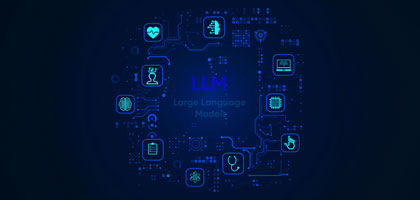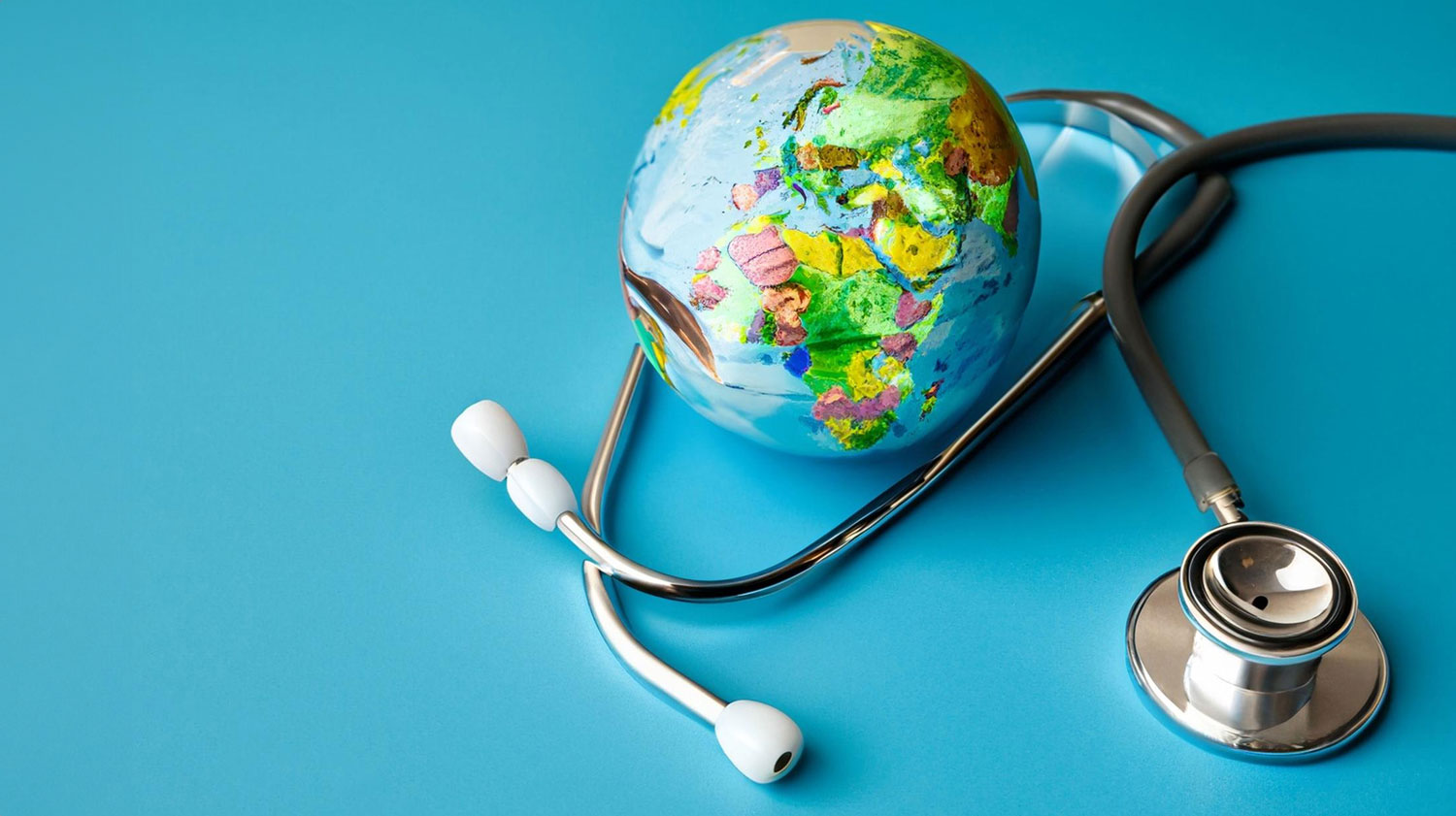
Blog
How AI and Large Language Models Transform Healthcare IT?
The healthcare IT industry stands at a crossroads. While large amounts of data exist, valuable insights often remain hidden, requiring transformative healthcare IT advancements. Thus, the primary question is: How can healthcare stakeholders utilize these datasets to create actionable plans for improved healthcare outcomes? While the sector continually advances to give reliable answers, a true paradigm shift emerges through the strategic implementation of Artificial Intelligence (AI) and, most importantly, LLMs.
LLMs, as exceptional machine learning models, are trained on extensive datasets to understand and generate human language. They're the driving force behind various applications that have the potential to revolutionize workflows across industries. One notable example that can be enough to display this prospect is OpenAI's GPT-4, a technology that excited the whole world by streamlining processes, enhancing efficiency and expanding access to critical information via a chatbot.
Then, how do we translate this massive potential into tangible benefits for patients, healthcare professionals and healthcare providers? By integrating LLMs into healthcare IT systems, a new era begins with intelligent healthcare assistants, personalized care plans and data-driven decision-making.
Our blog will explore the growing role of LLMs in healthcare IT and how healthcare authorities, professionals and patients benefit from them. We'll focus on LLMs' role in accessible healthcare and discuss their real-world impact with Tiga Healthcare Technologies, with a particular emphasis on democratizing healthcare.

The Journey Toward Accessible Healthcare
The labyrinthine nature of healthcare information can sometimes disorient even healthcare professionals due to different or conflicting formats. This is why the pursuit of accessible healthcare has become a major concern. Healthcare technologies must build a future where everyone, regardless of location, disability or background, receives the right treatment at the right time. This requires clear, concise and readily available information that empowers patients, healthcare professionals and providers.
However, healthcare IT advancements aimed at meeting this noble pursuit created a paradox. While data exploded in volume, valuable insights must have been more accessible but data was often locked away in isolated databases. AI and LLMs have emerged as the missing puzzle pieces, increasing the healthcare IT technologies' capacity to interpret big data.
The Digital Transformation of Healthcare Systems
In recent years, the healthcare industry has been on a fast-paced digital transformation journey to achieve greater operational efficiency, stronger collaboration and improved healthcare outcomes, all of which have grown through actionable data. Moreover, this transformation has come hand in hand with a new operational approach involving a diverse range of stakeholders, not just regulatory bodies, healthcare professionals and providers but also patients and their families, hospital personnel and NGOs. Accordingly, ongoing digitalization for ever-evolving needs is essential to ensure the success of this collaborative model.
Examples such as health information exchange systems, electronic health records and patient portals illustrate the evolution of healthcare information storage and sharing among various stakeholders, significantly enhancing communication and coordination.
Despite these advancements, these systems often need to improve the vast potential of the data they contain. Extracting actionable insights from complex medical records can be labor-intensive and susceptible to error. This is where a new wave of technologies, AI and Large Language Models (LLMs), emerged. LLMs, trained in vast amounts of medical literature and research data, analyze these complex records quickly and accurately.

The Rise of AI and LLMs in Healthcare
How about a chatbot that acts as a personalized healthcare companion, providing advice and guiding through a plan for unique situations? Further, physicians can utilize the deep analysis of unique medical histories and lifestyle choices. This future is no longer the stuff of science fiction writers; it is rapidly approaching thanks to the rise of AI, particularly LLMs in healthcare.
Unlike traditional software or programs, LLMs are trained on extensive datasets of healthcare literature, patient records or research findings. This way, they understand complex medical terms and identify hidden patterns within data that humans might miss. This is what makes LLMs powerful tools for developing intelligent healthcare assistants. They can grasp medical terminology and form meaningful connections in data within seconds. Consequently, research capabilities enhance, personalized treatment plans strengthen and data-driven decisions lead to better patient outcomes and proactive healthcare plans.
Integrating LLMs into healthcare IT systems isn't just about closing the digital divide for disadvantaged groups; it's about empowering patients with healthcare literacy, involving them in their care plans and allowing healthcare professionals and providers to make informed decisions.
LLMs have vast, evolving potential in healthcare IT, promising more efficient, proactive, personalized and effective care. However, it's important to remember that they are not replacements for human expertise. The true power lies in AI and human collaboration, increasing each other's strengths for healthier lives. Now, let's see how this collaboration works.

Enhancing Access to Healthcare Data & Information
For far too long, accessing and understanding healthcare data has been a privilege but as the Covid-19 pandemic shows, it should be a right. Complex medical terminology has created barriers between patients and their healthcare journey, preventing them from actively participating in their care. However, integrating LLMs into healthcare IT systems offers transformative solutions: enhancing access to healthcare information and promoting patient engagement in a way that makes lasting impacts. Let’s see how:
- Simplified Medical Language: LLMs translate complex medical terms into clear, simple language everyone can understand and even chat about! LLM applications have already created a healthcare environment where patients can easily grasp their diagnoses, treatment options and potential side effects. Further, this empowers patients to ask informed questions, voice their concerns and work collaboratively with their physicians.
- Increased Health Literacy: LLMs are instrumental in improving health literacy, enabling patients to access, understand and use health information effectively. These AI applications have the potential to create personalized learning materials, thoroughly answer patient questions and recommend reliable healthcare resources. LLMs encourage a proactive approach to healthcare management and disease prevention by empowering individuals with accurate information.
- Breaking Language Barriers: Language is no longer a barrier to accessing essential healthcare information, thanks to LLMs. They have the potential to provide multi-language support or real-time translation services, ensuring patients receive clear explanations of their health conditions regardless of their native tongue. This way, cultural sensitivity in healthcare delivery is no longer an issue and healthcare accessibility increases, ensuring everyone has an equal opportunity to understand their conditions.
For the best, the impact of LLMs extends far beyond simply providing information. They empower patients to participate actively in their healthcare journey, leading to better-informed decisions, improved health outcomes and a future where healthcare is truly accessible for all. Now, it's time to see how patients can use LLM applications.

Patient Engagement: Personalized and Proactive Care
LLMs present a new way to interact with technology, marking a departure from traditional reactive processes. These models simplify communication between healthcare professionals and patients, offering anytime accessibility without time constraints. They convey healthcare knowledge and facilitate communication through translations, chats and structured information summaries, which are especially beneficial for conditions with social stigma, such as addiction or sexually transmitted disease treatments. While they still have progress in developing empathy for emotionally challenging situations, they significantly enhance patient engagement levels. Then, how do LLM applications improve patient-centricity in healthcare?
- Virtual Health Assistants: The rise of virtual health assistants has transformed healthcare by offering personalized guidance through chatbots and mobile applications. These chatbots answer user queries, provide basic symptom checkers and help schedule relevant appointments. For instance, a medical chatbot for a children's hospital might answer a parent's questions about childhood rashes with necessary information and suggest contacting a pediatrician if needed.
Mobile health applications are typical among these assistants, offering a wider range of functionalities. For example, a diabetes app could track blood sugar levels, provide reminders and suggest healthy recipes based on a user's profile. This kind of coaching has significant complementary potential for chronic disease management.
Additionally, by automating routine tasks and providing instant information, these assistants free up healthcare professionals' time, allowing them to focus on more complex cases for operational efficiency. They help streamline healthcare delivery processes and promise personalized healthcare plans, transforming how patients manage their health and interact with the healthcare IT systems.
- Medical Chatbots: AI-based medical chatbots are currently being used to ask about symptoms and preliminary medical advice. Surprisingly, medical chatbots can gather detailed symptom information and deliver structured guidance with an efficiency that often rivals and sometimes even surpasses quick physician visits. Unlike physician consultations involving trial-and-error approaches, chatbots provide thorough assistance without time constraints.
This technology carries immense potential for the future of healthcare IT, with possible applications for handling initial interactions in healthcare facilities, such as triage. These chatbots could seamlessly direct patients to the most relevant healthcare professionals by overcoming the current limitations of inaccurate information. Ultimately, this would free up valuable time for healthcare professionals, allowing them to focus on delivering high-quality, efficient patient care.
- Diagnostic Tools & Health Monitoring: One of the critical strengths of LLMs is their ability to find subtle patterns and trends that the human eye might miss. According to the Physician Sentiment Survey, 42% of physicians said that identifying patterns and anomalies in patient data was a key benefit of using AI technology. This capacity leads to much more effective and definitive diagnosis solutions. For instance, an LLM could analyze years of blood pressure readings and identify a gradual increase that could indicate early-stage hypertension.
Moreover, wearable devices and smartphone apps transform health monitoring with the data they accumulate. These devices track various health data, including heart rate, sleep patterns and blood oxygen levels. AI algorithms and LLMs then analyze this information and identify potential health issues, prompting users to see a physician. For example, a smartwatch could detect heart rhythm irregularities and recommend that the user consult a doctor for further evaluation.
These integrations also help healthcare professionals handle many referrals and patient communication tasks. Overall, LLM-powered applications have the potential to improve healthcare delivery and patient outcomes significantly. By making accurate diagnostics and medical care more accessible, they empower everyone to take charge of their health. Still, how can they empower care at this level? The answer lies within research and education!

Democratizing Healthcare Knowledge: Research and Education
LLMs change healthcare research as genius research assistants, rapidly analyzing numerous papers and clinical trial data to enhance research outcomes and accelerate discoveries. Moreover, they democratize access to healthcare knowledge by generating clear, concise summaries of complex research findings. For instance, researchers using LLMs can collaborate across disciplines and close knowledge gaps to guide healthcare IT innovations.
- Open Access to Data: Is there a way for researchers to collaborate to tackle complex healthcare challenges and accelerate innovative treatments and diagnostic methods? Traditionally, medical research findings have often been locked away behind paywalls in academic journals. This restricts access for researchers, slowing down collaboration and, ultimately, collaboration. Open access to healthcare data with LLMs can shatter these barriers. By making research freely available, researchers and scientists allow a pool to analyze and build upon existing knowledge for more accessible healthcare.
- Improved Patient Outcomes: By continuously expanding a deeper understanding of healthcare conditions and their treatments, healthcare professionals and researchers can develop more effective interventions and improve patient outcomes. Additionally, enhanced research methodologies lead to more robust clinical trials, ensuring new treatments are safe and truly beneficial. This ongoing pursuit of knowledge through enhanced research is the key to unlocking a future of personalized healthcare plans and improved outcomes.
We thoroughly examined the use of AI, specifically LLMs, in healthcare and its impactful outcomes. Now, let's explore the future trends in this field.

Future Trends: The Horizons of Democratized Healthcare
The vision for a globally accessible healthcare system is gradually becoming a reality. Healthcare data analytics platforms have seen a wave in adoption, particularly in remote and underserved areas with limited access to healthcare facilities. For example, initiatives like the World Health Organization's Global Strategy on Digital Health specifically focus on mobile health applications to reach rural African and Asian populations. The increasing number of international partnerships and investments in AI-based health infrastructure facilitate the creation of cross-border health networks, ensuring that geographical boundaries do not confine high-quality medical care.
In essence, AI is a key player in democratizing healthcare with diagnostic accuracy, accelerated research and treatment personalization. Google's Med-PaLM exemplifies this by being designed to provide high-quality answers to medical questions. These innovations improve efficiency and ensure healthcare delivery equity, as they enable marginalized populations to access the same high-quality care as those in more developed regions. For the future, continued technological advancements promise a future where healthcare is universally accessible, affordable and equitable. Now, it's time to look closely at what Tiga did in light of this vision.
Real-World Impact: Tiga’s Role
Our suite of AI-powered solutions sits at the sweet spot where healthcare IT research boosts practical applications for real-world impact. While the AI & Analytics product family and our R&D projects focus on different areas to unlock the full potential of AI in healthcare IT, we continue to brainstorm and focus on LLMs. Let's look closer at our projects to see what we do for healthcare research, efficiency, predictive analytics and more.
Take, for example, ShareMind - AI Platform for Health. It accelerates healthcare research with advanced machine learning models that create customized research models while preserving data confidentiality. This platform delivers tools for data management, data preparation and ETL, also provides scalability, security and anonymized data analysis. By facilitating academic partnerships and offering safe access to extensive datasets, ShareMind supports scientific progress, improves population health and guides policy development, ultimately contributing to more accessible healthcare.
On the other hand, Predis is a healthcare analytics platform that empowers population health management strategies by meticulously analyzing health and pharmaceutical data to detect anomalies with predictive insights. Its features, such as multi-dimensional data shift detection, enhance predictive analytics for fast intervention, improving healthcare delivery safety and efficiency. Predis uses prescriptions, lab results and diagnostic codes to offer early warnings about epidemics and disease spread, aiding healthcare authorities in resource optimization and regulatory oversight and ultimately contributing to a more efficient healthcare environment.
Autononym changes information protection by employing AI to anonymize data across visual, tabular and textual formats, enhancing regulatory compliance while expanding research opportunities through secure data sharing. Designed for organizations with sensitive data, it anonymizes data for research while maintaining data value, transparency and integrity. Autononym ensures compliance with regulations like GDPR, KVVK and HIPAA, providing data breach protection, resource efficiency and public trust. Its AI-driven identification and anonymization capabilities set a new standard for security in the digital age.
For ongoing projects, we can give a successful example of AISym4Med. It provides engineers, practitioners and researchers with a data management platform. This platform offers a robust dataset system enhanced with controlled data synthesis for experimentation and modeling. By integrating anonymization methods, attribute-based privacy approaches and reliable tracking systems, AISym4Med ensures privacy and security, empowering healthcare professionals to advance research and confidently improve patient outcomes.
Another example is DMEK-Track, which solves a specific point in ophthalmology, facilitating corneal transplant follow-ups thanks to AI-based analysis of intermediate-level OCT (Optical Coherence Tomography) scans. Thanks to continuous and detailed monitoring, it detects potential issues proactively for better outcomes in a more accessible way.
Also, we have a platform for senior care called Closer - Elderly Smart Home. Its advanced emergency detection and motion-aware tracking capabilities enable real-time monitoring of elderly individuals. All this is done while protecting their privacy and using a cost-effective approach to enhance their quality of life.

Our innovations drive our mission to redefine treatment approaches and make healthcare delivery accessible with powerful AI solutions across various fields. We aim to develop sophisticated models that optimize workflows, enhance research and support informed decision-making, ultimately democratizing healthcare and improving patient outcomes.
We use the latest advancements in big data analytics to identify patterns and insights that were previously impossible to uncover. This means faster diagnoses, personalized treatment plans and more effective interventions, all leading to better patient care.
Moreover, our AI solutions are designed to integrate flawlessly with existing healthcare systems. This ensures that healthcare providers and professionals easily adopt and benefit from our technology without disrupting their workflow. Our goal is to enhance healthcare providers' capabilities, allowing them to focus on what they do best: caring for patients with enhanced collaboration.
Envision a future where healthcare providers, professionals and researchers unite with powerful AI products to enhance lives. Let's shape this future together!









